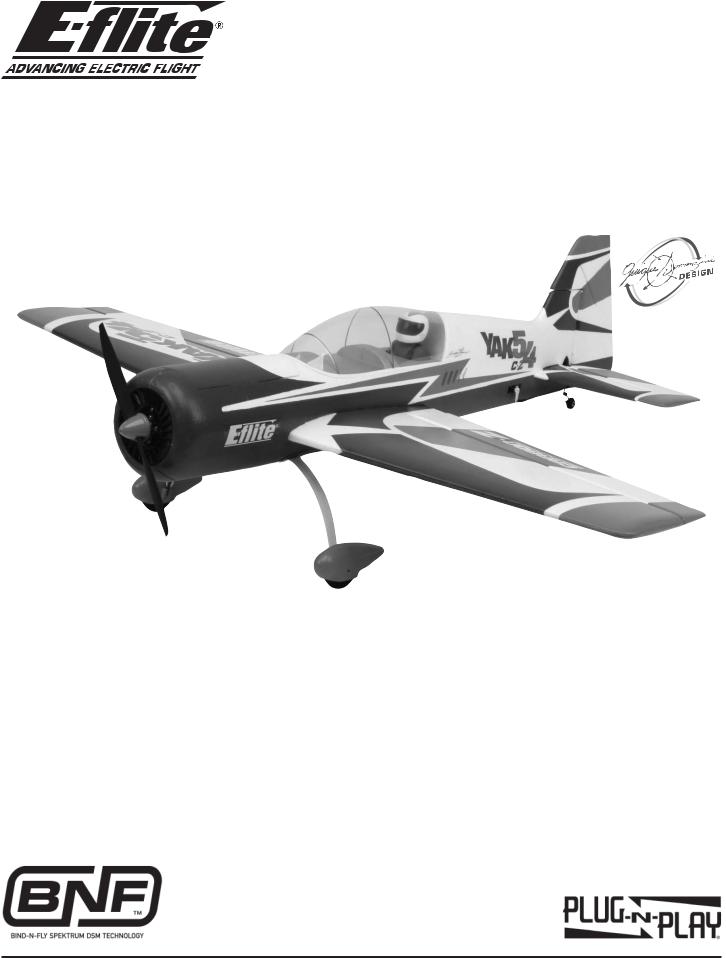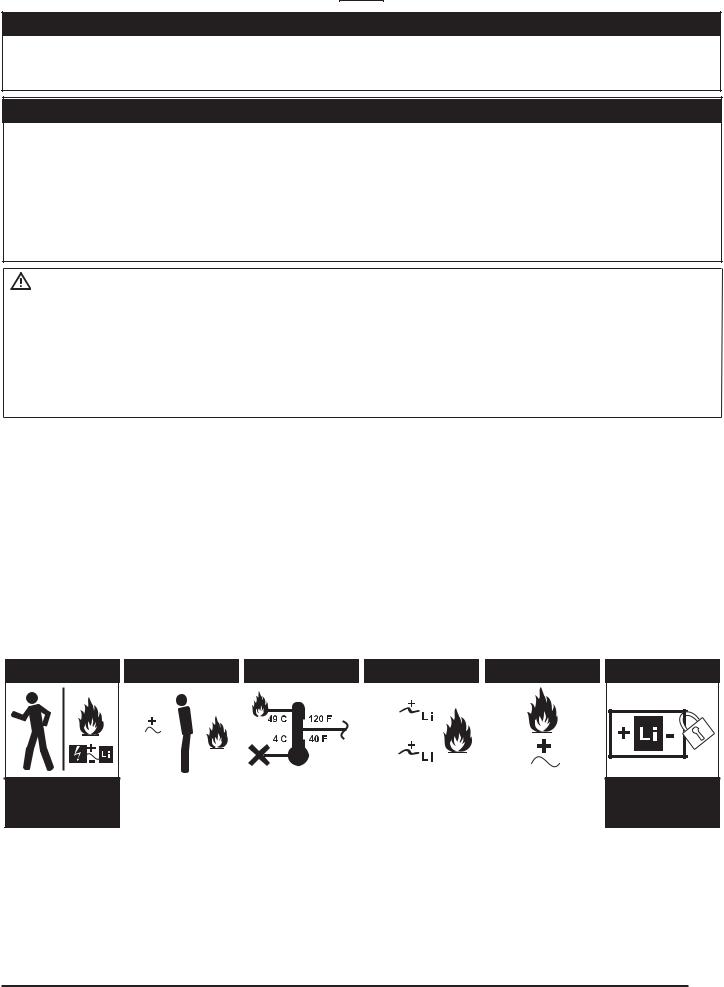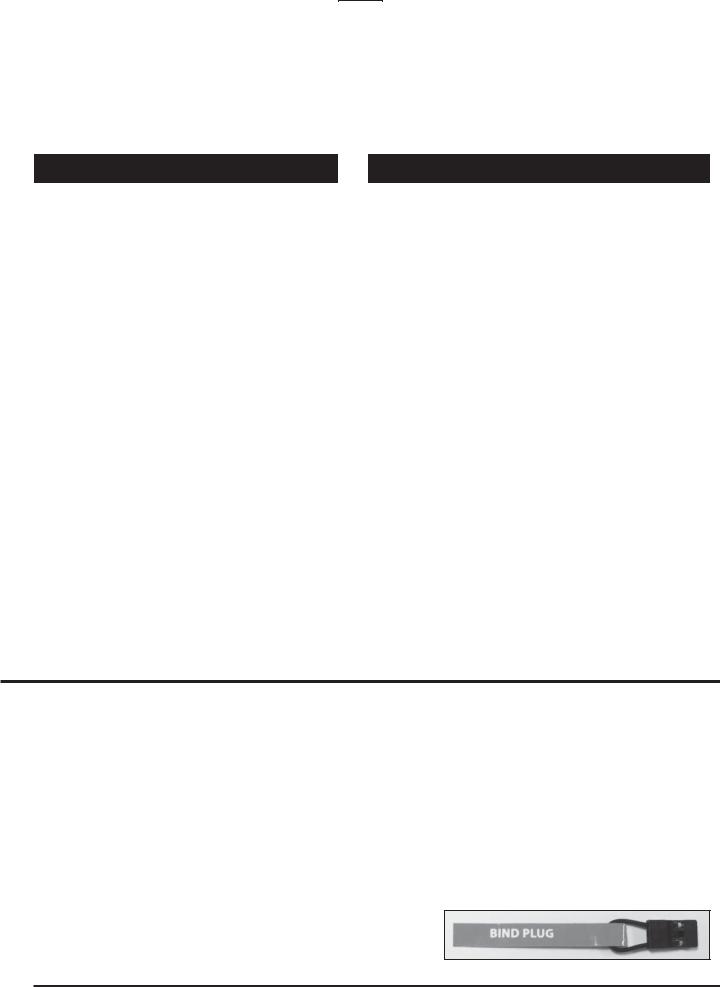E-flite Carbon-Z Yak 54 PNP User Manual

CARBON-Z YAK 54
Instruction Manual Bedienungsanleitung Manuel d’utilisation Manuale di Istruzioni

EN
2

EN
NOTICE
All instructions, warranties and other collateral documents are subject to change at the sole discretion of Horizon Hobby, Inc. For up-to-date product literature, visit http://www.horizonhobby.com and click on the support tab for this product.
Meaning of Special Language:
The following terms are used throughout the product literature to indicate various levels of potential harm when operating this product:
NOTICE: Procedures, which if not properly followed, create a possibility of physical property damage AND little or no possibility of injury.
CAUTION: Procedures, which if not properly followed, create the probability of physical property damage AND a possibility of serious injury.
WARNING: Procedures, which if not properly followed, create the probability of property damage, collateral damage, and serious injury OR create a high probability of superficial injury.
WARNING: Read the ENTIRE instruction manual to become familiar with the features of the product before operating. Failure to operate the product correctly can result in damage to the product, personal property
and cause serious injury.
This is a sophisticated hobby product and NOT a toy. It must be operated with caution and common sense and requires some basic mechanical ability. Failure to operate this Product in a safe and responsible manner could result in injury or damage to the product or other property. This product is not intended for use by children without direct adult supervision. Do not attempt disassembly, use with incompatible components or augment product in any way without the approval of Horizon Hobby, Inc. This manual contains instructions for safety, operation and maintenance. It is essential to read and follow all the instructions and warnings in the manual, prior to assembly, setup or use, in order to operate correctly and avoid damage or serious injury.
Safety Precautions and Warnings
As the user of this product, you are solely responsible for operating in a manner that does not endanger yourself and others or result in damage to the product or the property of others.
This model is controlled by a radio signal subject to interference from many sources outside your control. This interference can cause momentary loss of control so it is advisable to always keep a safe distance in all directions around your model, as this margin will help avoid collisions or injury.
Age Recommendation: Not for children under 14 years. This is not a toy.
•Never operate your model with low transmitter batteries.
•Always operate your model in an open area away from cars, traffic or people.
•Avoid operating your model in the street where injury or damage can occur.
•Never operate the model in the street or in populated areas for any reason.
•Carefully follow the directions and warnings for this and any optional support equipment (chargers, rechargeable battery packs, etc.) you use.
•Keep all chemicals, small parts and anything electrical out of the reach of children.
•Moisture causes damage to electronics. Avoid water exposure to all equipment not specifically designed and protected for this purpose.
•Never lick or place any portion of your model in your mouth as it could cause serious injury or even death.
 WARNING
WARNING
Never leave charging Batteries unattended.
 WARNING
WARNING  WARNING
WARNING  WARNING
WARNING  WARNING
WARNING
|
|
|
|
|
|
|
|
|
|
|
|
|
|
|
|
|
|
|
|
|
|
|
|
|
|
|
|
|
|
|
|
|
|
|
|
|
|
|
|
|
|
|
|
|
|
|
|
|
|
|
|
|
|
|
|
|
|
|
|
|
|
|
|
|
|
|
|
|
|
|
|
|
|
|
|
|
|
|
|
|
|
|
|
|
|
|
|
|
|
|
|
|
|
|
|
|
|
|
|
|
|
|
|
|
|
|
|
|
|
|
|
|
|
|
|
|
|
|
|
|
|
|
|
|
|
|
|
|
|
|
|
|
|
|
|
|
|
|
|
|
|
|
|
|
|
|
|
|
|
|
|
|
|
|
|
|
|
|
|
|
|
|
|
|
|
|
|
|
|
|
|
|
|
|
|
|
|
|
|
|
|
|
|
|
|
|
|
|
|
|
|
|
|
|
|
|
|
|
|
|
|
|
|
|
|
|
|
|
|
|
|
|
|
|
|
|
|
|
|
|
|
|
|
|
|
|
|
|
|
|
|
|
|
|
|
|
|
|
|
|
|
|
|
|
|
|
|
|
|
|
|
|
|
|
|
|
|
|
|
|
|
|
|
|
|
|
|
|
|
|
|
|
|
|
|
|
|
|
|
|
|
|
|
|
|
|
|
|
|
|
|
|
|
|
|
|
|
|
|
|
|
|
|
|
|
|
|
|
|
|
|
|
|
|
|
|
|
|
|
|
|
|
|
|
|
|
|
|
|
|
Always charge |
|
Never charge |
|
|
Never charge |
|
|
Never charge |
|||||||||||||||||||||||
|
Batteries away from |
|
Batteries outside safe |
|
|
Batteries outside |
|
|
||||||||||||||||||||||||
|
|
|
|
|
damaged Batteries. |
|||||||||||||||||||||||||||
|
flammable materials. |
|
temperature range. |
|
recommended levels. |
|
||||||||||||||||||||||||||
|
|
|
|
|
|
|
|
|
|
|
||||||||||||||||||||||
|
|
|
|
|
|
|
|
|
|
|
|
|
|
|
|
|
|
|
|
|
|
|
|
|
|
|
|
|
|
|
|
|
|
|
|
|
|
|
|
|
|
|
|
|
|
|
|
|
|
|
|
|
|
|
|
|
|
|
|
|
|
|
|
|
|
 WARNING
WARNING
Store |
Batteries safely. |
Battery Warnings and Guidelines
The Battery Charger (EFLC3015) included with the Carbon-Z Yak 54 BNF has been designed to safely charge the Li-Po battery.
 CAUTION: All instructions and warnings must be followed exactly. Mishandling of Li-Po batteries can result in a fire, personal injury, and/or
CAUTION: All instructions and warnings must be followed exactly. Mishandling of Li-Po batteries can result in a fire, personal injury, and/or
property damage.
•Do not cover the warnings on the back of the battery with hook and loop strips.
•By handling, charging or using the included Li-Po battery you assume all risks associated with lithium batteries.
•If you do not agree with these conditions, return your complete Carbon-Z Yak 54 model in new, unused condition to the place of purchase immediately.
3

|
|
EN |
|
• DO NOT USE A Ni-Cd OR Ni-MH CHARGER. Failure |
|
• When transporting or temporarily storing the |
|
to charge the battery with a compatible charger |
|
battery the temperature range should be from |
|
may cause fire resulting in personal injury and/or |
|
40–120º F. Do not store battery or model in a car |
|
property damage. |
|
or direct sunlight. If stored in a hot car, the battery |
|
• If at any time the battery begins to balloon or |
|
can be damaged or even catch fire. |
|
swell, discontinue use immediately. If charging or |
|
• Li-Po cells should not be discharged to below 3V |
|
discharging, discontinue charging and disconnect. |
|
each under load. |
|
Continuing to use, charge or discharge a battery |
|
|
|
that is ballooning or swelling can result in fire. |
In the case of the Li-Po battery used for the Carbon-Z |
||
• Store the battery at room temperature in a dry |
Yak 54, you will not want to allow the battery to fall |
||
area for best results. |
below 3V per cell during flight. |
||
|
|
|
|
The Carbon-Z Yak 54 is a semi scale 3D performer designed by Quique Somenzini. It features a new construction process that brings foam constructed airplanes onto the same playing field as balsa. Carbon-Z material comes from a process that combines foam with carbon fiber reinforcements, making it stronger than balsa but with no additional weight.
The foam outer material is designed to survive minor crashes with minimal damage. However, in the event of a crash, the Carbon-Z Yak 54 is designed to be easy to repair. Minor dents to the foam outer surface can be repaired easily in the field. The aircraft is also modularly designed to make replacement of damaged sections easy. The resulting product is a great flying plane that will spend more time in the air and less time in the
workshop. The Carbon-Z Yak 54 will be tuned to specifications recommended by Quique Somenzini himself. All components, from the servos to the motor, have been selected and tuned to optimize the plane’s performance.
Table of Contents |
|
Table of Contents .................................................................... |
4 |
Low Voltage Cutoff (LVC) ....................................................... |
5 |
Charging the Flight Battery.................................................... |
5 |
General Assembly and MaintenanceTips............................. |
6 |
Transmitter and Receiver Binding ......................................... |
6 |
Installing Landing Gear.......................................................... |
7 |
Installing Rudder..................................................................... |
8 |
Installing Wings....................................................................... |
8 |
Installing HorizontalTail and Pushrods on Control Horns ... |
9 |
Installing the Flight Battery.................................................. |
10 |
Removing the Control Surfaces........................................... |
11 |
PNP Installation..................................................................... |
13 |
Range Check and Pre-FlyingTips......................................... |
13 |
FlyingTips and Repairs ........................................................ |
13 |
2010 Official Academy of Model Aeronautics Safety Code14 |
|
Troubleshooting Guide......................................................... |
15 |
Replacement Parts ................................................................ |
16 |
Warranty and Repair Policy.................................................. |
17 |
Contact Information.............................................................. |
18 |
|
Carbon-Z Yak 54 |
Bind-N-Fly |
Plug- |
||
|
N-Play |
||||
|
Features |
Version |
|||
|
Version |
||||
|
|
|
|||
|
|
|
|
||
Motor |
|
|
|
||
BL25 Brushless |
Installed |
Installed |
|||
Outrunner, 1000Kv |
|
|
|
||
ESC |
|
|
|
||
E-flite® Pro 60A brushless |
Installed |
Installed |
|||
with Switch-Mode BEC |
|
|
|
||
Receiver |
|
|
|
||
Spektrum™ AR600 |
Installed |
Sold |
|||
DSM2™ |
Separately |
||||
|
|||||
6-channel sport receiver * |
|
|
|
||
|
|
|
|
||
Battery |
|
Sold |
|||
4S 14.8V 2800mAh 30C |
Included |
||||
Separately |
|||||
Li-Po |
|
||||
|
|
|
|||
|
|
|
|
||
Charger |
|
|
|
||
Variable rate 3-to 4-cell |
Included |
Sold |
|||
Li-Po balancing fast |
Separately |
||||
|
|||||
charger |
|
|
|
||
|
|
|
|
||
Transmitter |
Sold |
Sold |
|||
Full range DSM2 |
|||||
Separately |
Separately |
||||
aircraft transmitter * |
|||||
|
|
|
|||
|
|
|
|
|
|
|
* Recommended for Plug-N-Play Version |
|
|
||
|
|
|
|
|
|
|
Carbon-Z Yak 54 Specifications |
|
|
||
|
Wingspan |
48 in (1220mm) |
|
||
|
|
|
|
|
|
|
Length |
48.5 in (1232mm) |
|
||
|
Weight (RTF) |
3.75-3.81 lb (1700-1730 g) |
|
||
|
|
|
|
|
|
To register your product online, go to www.e-fliterc.com
4

EN
®
Charging the Flight Battery
Your E-flite Carbon-Z Yak 54 comes with a DC balancing charger and 4S Li-Po battery. You must charge the included Li-Po battery pack with a Li-Po specific charger only (such as the included charger). Never leave the battery and charger unattended during the charge process. Failure to follow the instructions properly could result in a fire. When charging, make certain
the battery is on a heat-resistant surface. Charge the battery pack while you are assembling the aircraft. You will need the flight battery to confirm proper aircraft operation in future steps.
DC Li-Po Balancing Charger Features
•Charges 3-to 4-cell lithium polymer battery packs
•Variable charge rates from 500mAh to 3-amp
•Simple single push-button operation
•LED charge status indicator
•LED cell balance indicator
•Audible beeper indicates power and charge status
•12V accessory outlet input cord
Specifications
•Input power: 12V DC, 3-amp
•Charges 3- to 4-cell Li-Po packs with minimum capacity of 500mAh
4S 14.8V 2800mAh Li-Po Battery Pack
The E-flite 4S Li-Po battery pack features a balancing lead that allows you to safely charge your battery pack when used with the included E-flite Li-Po
balancing charger.
The Battery Charging Process
1.Charge only batteries that are cool to the touch and are not damaged. Look at the battery to make sure it is not damaged e.g., swollen, bent, broken or punctured.
2.Attach the input cord of the charger to the appropriate power supply (12V accessory outlet).
3.When the Li-Po charger is correctly powered up, there is an approximate 3-second delay, then an audible “beep” and the green (ready) LED will flash.
4.Turn the control on the Amps selector so the arrow points to the charging rate required for the Battery. (See chart, for example the Yak 54 2800mAh Li-Po battery will charge at 3.0 amps.) DO NOT change the charge rate once the battery begins charging.
5.Move the cell selector switch to 3-cell or 4-cell for your battery.
6.Connect the Balancing Lead of the Battery to the 3-cell (4 pins) or 4-cell (5 pins) Charger port.
7.The green and red LEDs may flash during the charging process, when the charger is balancing cells. Balancing prolongs the life of the battery.
8.When the battery is fully charged, an audible beep will sound for about 3 seconds, and the green LED will shine continuously.
9.Always unplug the battery from the charger
immediately upon completion of charging. CAUTION: Overcharging a battery can cause a fire.
|
|
|
|
Battery Capacity |
Maximum Charge Rate |
|
|
|
|
500-1000mAh |
500mA |
|
|
|
|
|
|
|
|
|
|
1000-1500mAh |
1A |
|
|
|
|
|
|
|
|
|
|
1500-2000mAh |
1.5A |
|
WARNING: Failure to use the proper charger for a |
|
2000-2500mAh |
2.0A |
|
Li-Po battery can result in serious damage, and if left |
|
3000mAh + |
3.0A |
||
charging long enough, will cause a fire. ALWAYS use |
|
||||
|
|
|
|||
caution when charging Li-Po batteries. |
|
|
|
||
|
WARNING: Selecting a charge rate higher than 1x |
|
|
|
|
(one times) the battery capacity may cause a fire. |
|
|
|
||
|
|
||||
Low Voltage Cutoff (LVC) |
When the motor pulses, please land the aircraft |
||||
|
|
|
immediately and recharge the flight battery. |
||
When a Li-Po battery is discharged below 3V per |
Disconnect and remove the Li-Po battery from the |
||||
cell, it will not hold a charge. The Carbon-Z Yak 54 |
aircraft after use to prevent trickle discharge. Fully |
||||
Electronic Speed Control protects the flight battery |
charge your Li-Po battery before storing it. |
||||
from over-discharge using Low Voltage Cutoff (LVC). |
During storage make sure battery charge does not go |
||||
Before the battery charge decreases too much, LVC |
|||||
removes power from the motor. Power to the motor |
below 3V per cell. |
|
|||
pulses, showing that some battery power is reserved |
Note: The speed control is programmed for 4S LVC. |
||||
for flight control and safe landing. |
|
|
|
||
5

EN
General Assembly and
Maintenance Tips
Note: This checklist is not a replacement for the content included in this manual. Although you can use it as a quick start guide, we strongly suggest reading through this manual completely before proceeding.
First Flight Preparation
|
Activity |
BNF |
PNP |
|
Remove and inspect contents |
|
|
|
|
|
|
|
Begin charging flight battery |
|
|
|
|
|
|
|
Assemble Carbon-ZYak 54 |
|
|
|
|
|
|
|
Install the landing gear |
|
|
|
|
|
|
|
Install the stab |
|
|
|
|
|
|
|
Install rudder and elevator |
|
|
|
push rod |
||
|
|
|
|
|
Install the wings |
|
|
|
|
|
|
|
Install receiver |
|
|
|
|
|
|
|
Connect servos to receiver or |
|
|
|
Y-harness |
||
|
|
|
|
|
Install fully charged battery |
|
|
|
|
|
|
|
Bind the receiver to a |
|
|
|
transmitter, if applicable |
||
|
|
|
|
|
Perform the Control Direction |
|
|
|
Test with the transmitter |
||
|
|
|
|
|
Adjust flight controls and |
|
|
|
transmitter |
||
|
|
|
|
|
Adjust battery for center of |
|
|
|
gravity (CG) see installing the |
|
|
|
flight battery. |
|
|
|
Perform a radio system |
|
|
|
Range Check |
||
|
|
|
|
|
Find a safe and open flying field |
|
|
|
|
|
|
|
Plan flight for flying field |
|
|
|
conditions |
||
|
|
|
Maintenance After Flying
|
|
Activity |
BNF |
PNP |
|
Disconnect flight battery from |
|
|
|
|
ESC (Required for Safety) |
|||
|
|
|
||
|
Turn off transmitter (Required |
|
|
|
|
for Safety) |
|||
|
|
|
||
|
Remove flight battery |
|
|
|
|
from aircraft |
|||
|
|
|
||
|
Recharge flight battery |
|
|
|
|
|
|
|
|
|
Clean aircraft (wipe off dirt, etc.) |
|
|
|
|
|
|
|
|
|
Repair or replace all |
|
|
|
|
damaged parts |
|||
|
|
|
||
|
Carefully disassemble and |
|
|
|
|
store aircraft |
|||
|
|
|
||
|
Store flight battery apart from |
|
|
|
|
aircraft |
and monitor the |
|
|
|
battery charge |
|
|
|
Transmitter and Receiver Binding
Binding is connecting a transmitter to an aircraft receiver wirelessly or electronically so the aircraft receiver recognizes the transmitter GUID (Globally Unique Identifier) code. Binding is necessary for proper operation.
Note: The Carbon-Z Yak 54 BNF requires a DSM2 full range (high power) transmitter. Any JR or Spektrum DSM2 transmitter can bind to the Spektrum AR600 receiver. Due to the aerobatic nature of the Carbon-Z Yak 54, we recommend using a transmitter with adjustable exponential and dual rates. Please visit www.bindnfly.com for a complete list of
compatible transmitters.
Note: When using a Futaba transmitter with a Spektrum module,you may need to reverse the throttle channel.
 CAUTION: ALWAYS power on the transmitter before connecting the flight battery to the aircraft ESC. ALWAYS disconnect the flight battery from the aircraft ESC before powering off the transmitter.
CAUTION: ALWAYS power on the transmitter before connecting the flight battery to the aircraft ESC. ALWAYS disconnect the flight battery from the aircraft ESC before powering off the transmitter.
Additional Binding Information
Before each flight, power on the transmitter and wait about 5 seconds before powering on the ESC. The transmitter scans and secures two radio frequencies for aircraft control. When the flight battery is connected too quickly for the transmitter to make frequency selection, the transmitter and receiver may not connect. When there is no connection, leave the transmitter powered on, disconnect the flight battery then reconnect the flight battery to the receiver.
6
